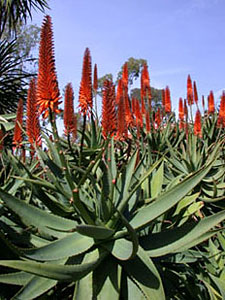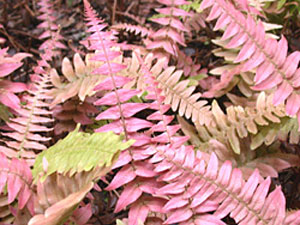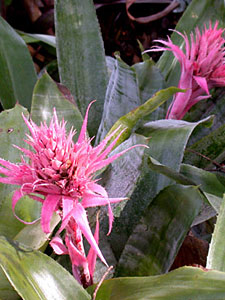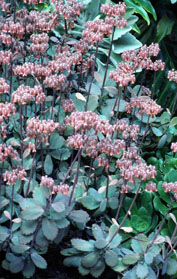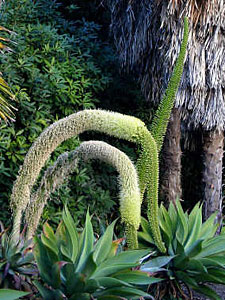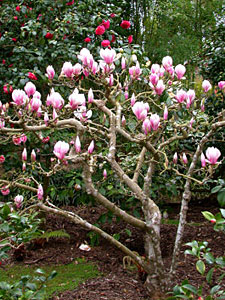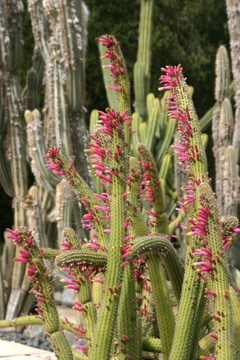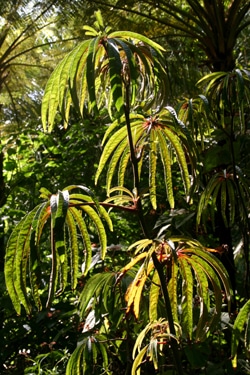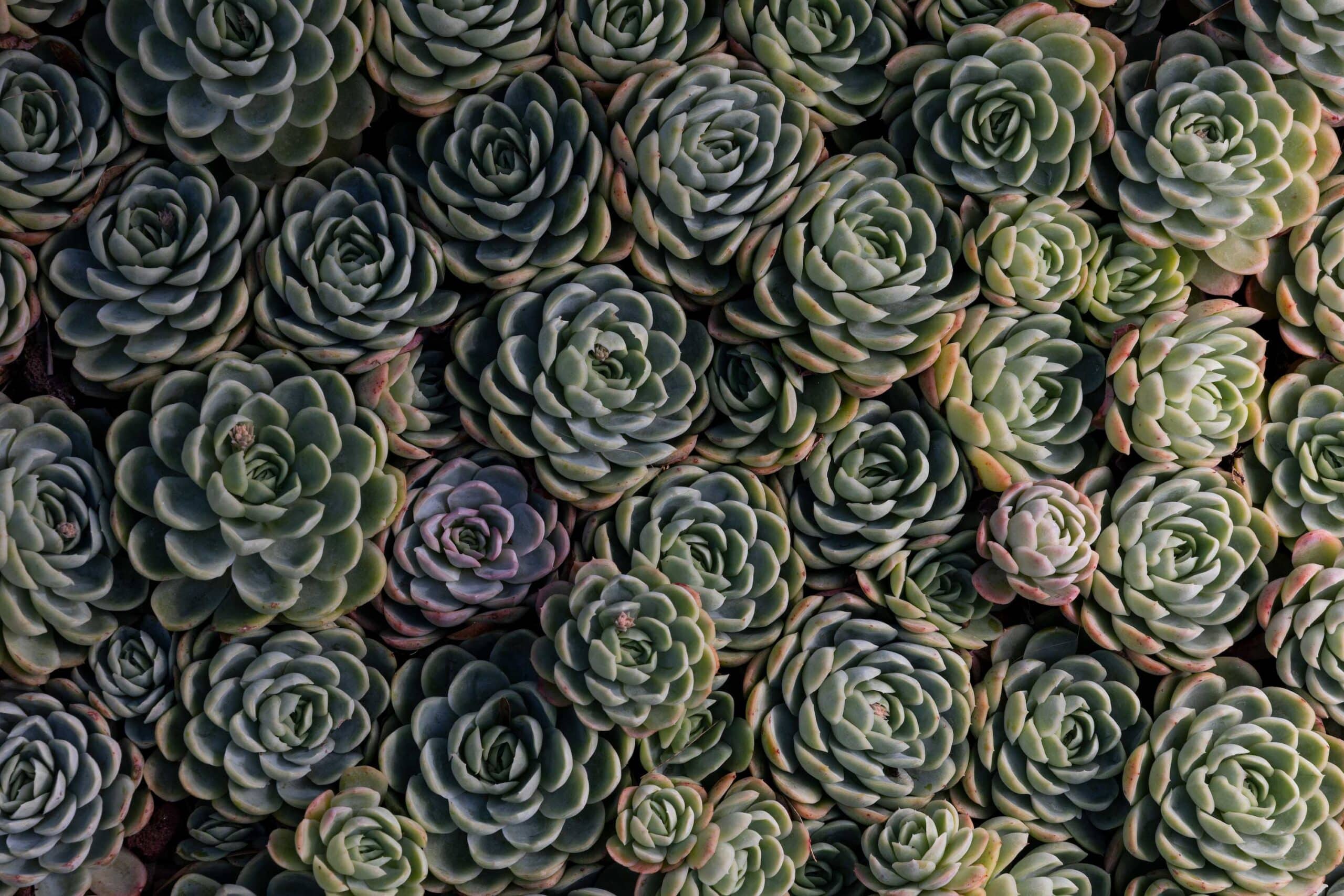
Plant Highlights
Plant Highlights
-
Aloe arborescens
candelabra aloe
Highlight Month:
February
Nativity:
South Africa
Growth Habit:
A clumping perennial with groups of stems spreading 10 feet tall and 6 feet wide.
Growing Requirements:
Shade to partial sun, moderate water. It can adapt to a wide variety of soil types.
Features:
A. arborescens has spikes of deep red flowers which bloom profusely through the winter months. It is one of more common aloe seen in Santa Barbara.
Where at Lotusland:
There are many specimens of A. arborescens throughout the Aloe Garden. There is also a planting along the Main Drive by the Sycamore Canyon gate.
-
Blechnum appendiculatum
hammock fern, palm fern
Highlight Month:
March
Nativity:
SE United States and American West Indies
Growth Habit:
This clumping fern spreads underground via rhizomes and forms a dense groundcover up to 2 feet tall. It displays striking pink new fronds in the spring.
Growing Requirements:
Blechnum appendiculatum grows best in partial sun to full shade, in moist soil. It makes an excellent ground cover.
Features:
This fern has long been misidentified as Blechnum occidentale in cultivation and the correct identification for this species is B. appendiculatum due to the presence of hairs on the rachis underside. Species in the genus Blechnum can easily be recognized by the presence of bar-like sori that run parallel to the costae (midvein) of each individual pinna (leaflet).
Where at Lotusland:
Blechnum appendiculatum is planted throughout the Fern Garden and in the Lower Bromeliad Garden.
-
Euphorbia lambii
tree euphorbia
Highlight Month:
March
Nativity:
Euphorbia lambii is a semi-succulent species native to the island of La Gomera in the Canary Islands.
Growth Habit:
Initially growing as a single trunk, it quickly branches to form a shrub/small tree reaching 6-10’ tall with attractive “pom-pom” clusters of blue-green leaves. In early spring, small lime green cupped bracts develop and bear multiple small flowers in a unique structure called a cyathium. This plant will likely spread in the garden unless the seeds are removed before fully developing.
Growing Requirements:
This species grows best in full sun to part-shade with some supplemental water during the active growing season. It tolerates a wide range of soil types and light frost.
Features:
Recent genetic analysis has revealed E. lambii (sometimes called Euphorbia lambiorum) to be synonymous with E. bourgaeana, a smaller growing species native to Tenerife, the largest of the Canary Islands.
Where at Lotusland:
Euphorbia lambii can be found along the Euphorbia side of the Main Drive near the entrance to the Palmetum.
-
Aechmea fasciata
Highlight Month:
February
Nativity:
Brazil
Growth Habit:
The vase-like rosette of leaves of this bromeliad is gray-green with a row of black spines along the margins. Plants produce bright pink inflorescences after several years. While the original plant will die after flowering, it will produce several offsets that may be removed and replanted. It is usually epiphytic in its native range, but adapts well to containers or raised beds outdoors.
Growing Requirements:
Grow Aechmea fasciata in bright shade either in a pot or in the ground with lots of organic material incorporated into the soil mix. Soil may be allowed to dry out between waterings, but maintain the central cup – made by the tightly overlapping leaves – full of water at all times. Fertilize every month or two with half-strength liquid fertilizer in the central cup.
Features:
This bromeliad is probably one of the best known and easiest to grow. It is regularly available in nurseries, home improvement centers and supermarkets.
Where at Lotusland:
There are a number of plants in both the Upper and Lower Bromeliad Gardens.
-
Kalanchoe fedtschenkoi
lavender scallops
Highlight Month:
February
Nativity:
Central & S. Central Madagascar
Growth Habit:
This succulent-leaved plant forms sturdy stems that are topped with clusters of nodding, bell-shaped flowers. They are an interesting shade of dusky rose that contrasts nicely with the bluish gray of the leaves. In winter, when the flowers are emerging, the leaves may also take on a reddish tinge because of the cold.
Growing Requirements:
This kalanchoe is readily propagated from stem cuttings or by simply sticking the base of a leaf in well-drained soil. Grow in full sun to moderate shade. It is very drought tolerant and requires no supplemental water once established.
Features:
The flattened leaves are scalloped along the margins and are often held at an optimum angle toward the sun, making the whole plant look two dimensional.
Where at Lotusland:
Growing at the base of the tall Kalanchoe beharensis plants near the bromeliads and succulents.
-
Agave attenuata
foxtail agave
Highlight Month:
February
Nativity:
Mexico (México State, Central Jalisco, Michoacán)
Growth Habit:
This agave is among only a few that do not have sharp spines along the edges or at the tip of its leaves. The leaves are soft and light green forming rosettes up to four feet across. It often branches near the base of a stalk to form larger clumps. The inflorescences arch up and then toward the ground and individual flowers bloom in succession from the base to the tip over a long period. A blue-leaved selection (Agave attenuata ‘Boutin Blue’) has erect inflorescences. Both types often produce many little plantlets along the spent flower stalk that will root on the ground if given the chance.
Growing Requirements:
Agaves are by and large desert plants. Their succulent leaves store water through dry periods making them extremely drought tolerant. Give them good drainage and a sunny or only slightly shaded site.
Features:
The bold rosettes of leaves provide a good accent plant in the drought tolerant garden. They even blend well with more tropical looking plants.
Where at Lotusland:
Lining the Main Drive just inside the Sycamore Canyon Gate. ‘Boutin Blue’ grows in the Blue Garden and a variegated form grows in the Pavilion Patio.
-
Magnolia x soulangeana
saucer magnolia
Highlight Month:
February
Nativity:
Garden Origin
Growth Habit:
This deciduous magnolia may grow as a multi-trunked or single-stemmed bush. It usually grows 10 to 15 feet in height. Flowers appear in early spring before the glossy green leaves.
Growing Requirements:
While perfectly happy in our Mediterranean climate, this magnolia will also thrive in temperate climates. Likes regular water and rich, well-amended soil.
Features:
The showy flowers are cup shaped, reddish purple on the outside shading to nearly white on the inside. It is a hybrid of Magnolia denudata and M. liliiflora.
Where at Lotusland:
Japanese Garden
-
Cleistocactus smaragdiflorus
Highlight Month:
February
Nativity:
Bolivia to NW. Argentina
Growth Habit:
This cactus grows as a multi-stemmed shrub. The plant is densely branching at the base producing many stems that are 2 to 3 inches in diameter with 12 to 16 ribs.
Growing Requirements:
Fast-draining soil and full sun are required. Water regularly through the hot summer months. Protect from frost.
Features:
The numerous narrow tubular flowers appear nearly year round. They are bright pinkish red with a yellowish green tip.
Where at Lotusland:
Cactus Garden
-
Begonia luxurians
palm leaf begonia
Highlight Month:
February
Nativity:
Brazil
Growth Habit:
This cane-type begonia grows up to 8 feet tall. Clusters of lightly fragrant white flowers appear from spring through fall.
Growing Requirements:
Grow in partial sun to shade in a protected spot; it will recover from light frosts. The palm leaf begonia requires even moisture to replicate its tropical forest home.
Features:
Distinctive leaves are the main feature of this begonia. They are palmately divided and reflexed, resembling miniature palms. This species is used frequently in Begonia hybridization.
Where at Lotusland:
Fern Garden
-
Helleborus argutifolius
Corsican hellebore, holly-leaved hellebore
Highlight Month:
February
Nativity:
Islands of Corsica and Sardinia in the Mediterranean Sea
Growth Habit:
Cup-shaped flowers with prominent creamy, pale green sepals persist for weeks from late fall to spring in Santa Barbara. The petals are reduced and appear as cone-like structures bearing nectar for visiting pollinators. In the garden, this plant will easily propagate itself from seed unless the flowering stalks are cut back before maturity.
Growing Requirements:
H. argutifolius prefers full sun to partial shade, is drought tolerant once established, and is hardy to USDA Zone 7.
Features:
This member of the buttercup family is one of fifteen Helleborus species. It is a member of the subgenus Helleborus, a group of four species with caulescent (above-ground) stems bearing leaves. The specific epithet, argutifolius, means “sharp-toothed leaves,” and references its glossy, evergreen leaves with serrate margins, reminiscent of a holly.
Where at Lotusland:
Japanese Garden


